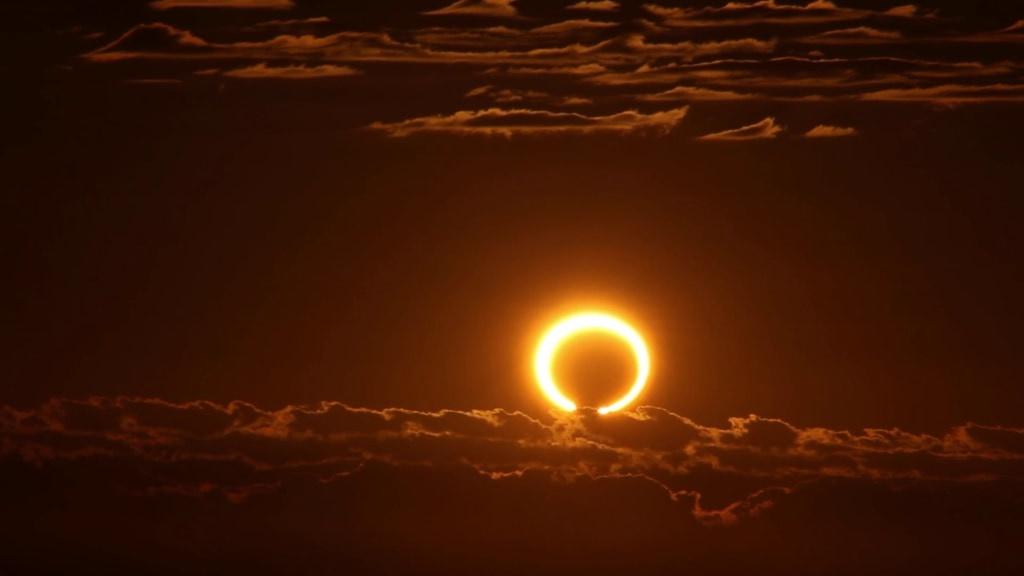An annular solar eclipse—also called a “ring of fire”—is coming to the US Southwest. On October 14, 2023, most of North, Central and South America will see a partial solar eclipse as the moon appears to take a chunk from the sun, but only from a 130 miles wide path will it be possible to see the “ring of fire.”
To see this particularly pretty partial solar eclipse it you’ll need to be within the path in Oregon, California, Nevada, Utah, Colorado, Arizona, New Mexico or Texas.
Here’s a map of the path from GreatAmericanEclipse.com
There are thousands of locations you could be on October 14 that will see the “ring of fire,” but here are a selection of organized events and easy-to-reach beauty spots:
Fort Klamath, Oregon
The first US state to see the “ring of fire” is Oregon, but it’s worth avoiding its coast, which can often be covered in mist and cloud. Inland, however, the chances of a clear sky massively increase. In Klamath County, below Crater Lake National Park, the EclipseFest 2023 event will include camping, RVs, food, live music from Smash Mouth—and a “ring of fire” at 9:17 a.m. PDT for 4 minutes 22 seconds.
Ely, Nevada
A three-hour drive north of Las Vegas, Ely is the gateway to the Great Basin National Park in the Snake Range. The “ring of fire” will pass over that park’s Astronomy Amphitheater at 9:24 a.m. PDT for 3 minutes 48 seconds while back in Ely it will last 3 minutes, 33 seconds. Ely will host a Ring of Fire Eclipse Festival and NASA will be live-streaming the event nationally.
Kodachrome Basin State Park, Utah
Less visited than nearby Bryce Canyon National Park and with a slightly longer “ring of fire,” Kodachrome Basin State Park at 5,800 feet above sea level would make a great location. Its hoodoos and colorful sedimentary pipes are almost the equal of its more famous neighbor. The ring will appear at 10:28 a.m. MDT for 2 minutes, 29 seconds.
Canyonlands National Park, Utah
It’s on the northern edge of the path, so Canyonlands National Park gets a short “ring of fire,” but arguably something just as interesting. As well as the ring for a few seconds viewers in this location should see lots of tiny beads of light fizzing around the edge of the moon just before and after the “ring moment.” Head down Grand View Point Road and pick from one of several viewing spots along the way, but pick according to what you want to see because while the farthest point, Grand View Point Overlook, has a 1 minute, 8 seconds ring at 10:30 a.m. MDT, Buck Canyon Overlook gets 27 seconds and Green River Overlook precisely zero seconds (which will be perfect for bead-spotting!).
Albuquerque International Balloon Fiesta, New Mexico
As luck would have it the penultimate day of the annual Albuquerque International Balloon Fiesta coincides with the annular solar eclipse. That’s either a not-to-be-missed coincidence or something to be avoided if you hate crowds. Either way, Albuquerque is destined to be ground zero for this eclipse, so book accomodation and tickets well ahead. The eclipse is at 10:34 a.m. MDT for 4 minutes, 43 seconds.
Fredericksburg, Texas
A 120 miles-square quadrant of Texas will experience two solar eclipses in less than six months, with a total solar eclipse on April 8, 2024. One of the lucky areas is Fredericksburg in the Texas Hill Country, whose Grapetown Vineyard eight miles south of downtown will host a campout with live music. The ring will appear at 11:51 a.m. CDT for 2 minutes, 31 seconds.
Stonehenge II, Texas
With no solar eclipse visible from the real thing in England for the best part of four centuries your only option for a neolithic location for a “ring of fire” is at 11:50 a.m. CDT for 4 minutes, 9 seconds at this mock-up in Ingram, Texas. On the campus of the Hill Country Arts Foundation, tickets are now on sale. The same location will also experience totality on April 8, 2024.
Disclaimer: I am the editor of WhenIsTheNextEclipse.com and author of “The Complete Guide To The Great North American Eclipse of April 8, 2024.”
Wishing you clear skies and wide eyes.
Read the full article here





